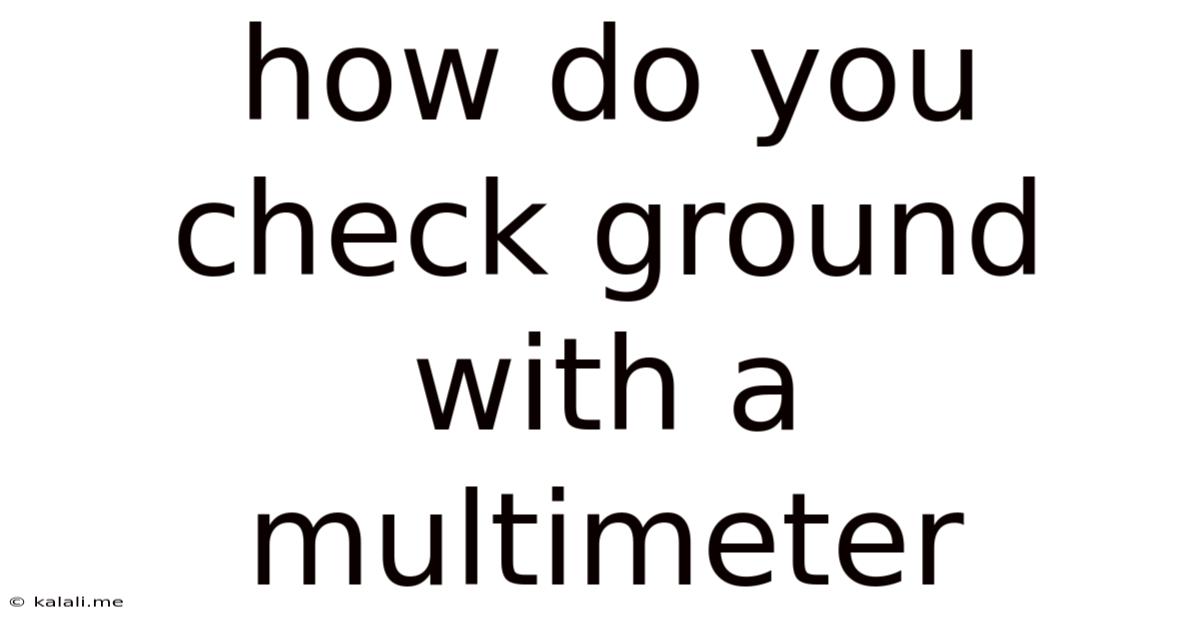How Do You Check Ground With A Multimeter
Kalali
Jun 09, 2025 · 3 min read

Table of Contents
How to Check Ground with a Multimeter: A Comprehensive Guide
Knowing how to check ground with a multimeter is a crucial skill for anyone working with electricity, whether you're a seasoned electrician or a DIY enthusiast. A properly grounded system is essential for safety and preventing damage to your electrical equipment. This comprehensive guide will walk you through the process, explaining different methods and highlighting important safety precautions. This article will cover testing ground continuity, voltage to ground, and identifying ground faults.
Safety First: Essential Precautions Before You Begin
Before you even touch your multimeter, prioritize safety. Always disconnect the power source before testing any electrical circuit. This might involve turning off the breaker at the electrical panel or unplugging the appliance. Never assume a circuit is dead; always double-check. Wear appropriate safety glasses and insulated gloves to protect yourself from electrical shocks.
Tools You'll Need
- Multimeter: A digital multimeter (DMM) is recommended for its accuracy and ease of use.
- Test Leads: Ensure your test leads are in good condition and properly connected to the multimeter.
- Screwdriver (if necessary): For accessing ground points in electrical outlets or appliances.
Methods for Checking Ground with a Multimeter
There are several ways to check ground using a multimeter, each designed for a specific purpose.
1. Checking Ground Continuity
This method verifies that the ground wire provides a continuous, low-resistance path to earth.
- Set your multimeter: Set the dial to the ohms (Ω) function. A low resistance reading indicates a good ground connection.
- Connect the leads: Connect one test lead to the ground point (e.g., a grounding screw on an outlet or appliance) and the other test lead to a known good ground, such as a metal water pipe (ensure it's actually grounded and not plastic piping).
- Read the resistance: A low resistance reading (ideally below 1 ohm) signifies a good ground connection. Higher resistance suggests a problem in the grounding path that needs further investigation. Readings of several ohms or more should be taken seriously and often mean you need a new ground wire. An infinite reading indicates no connection at all.
2. Checking Voltage to Ground
This method measures the voltage between the ground point and neutral wire to confirm that the ground is at the correct potential.
- Set your multimeter: Set the dial to the AC voltage (VAC) function. The specific voltage will depend on your system (e.g., 120V in North America, 230V in Europe).
- Connect the leads: Connect one lead to the ground point and the other to the neutral wire (white wire in most systems).
- Read the voltage: Ideally, the voltage reading should be very close to zero. A significant voltage difference indicates a ground fault, potentially dangerous.
3. Identifying Ground Faults using a Continuity Test
A ground fault indicates a problem within the wiring, where a live wire is inadvertently contacting the ground wire. This can cause dangerous electrical shocks or equipment damage.
- Set your multimeter: Set the multimeter to the continuity test setting (usually symbolized by a diode or a continuity symbol).
- Isolate the circuit: Turn off the power to the circuit being tested.
- Test the ground wire: Disconnect the ground wire from the circuit and test its continuity. You can test between the ground terminal and the chassis of the equipment. A continuous beep indicates a good connection.
- Test the circuit for faults: Testing the circuit while power is off might reveal issues with internal connections or insulation faults, resulting in a lack of continuity.
Interpreting Your Readings
Understanding the readings from your multimeter is crucial for accurate diagnostics:
- Low resistance (continuity test): Indicates a good ground connection.
- High resistance (continuity test): Suggests a problem in the grounding path (loose connection, corroded wire, etc.).
- Infinite resistance (continuity test): Indicates a broken or non-existent ground connection.
- Voltage close to zero (voltage test): Indicates a correctly grounded system.
- Significant voltage (voltage test): Indicates a serious ground fault.
Remember, consistently following safety procedures is paramount. If you are unsure about any aspect of electrical work, consult a qualified electrician. This guide provides basic information and should not replace professional electrical expertise.
Latest Posts
Latest Posts
-
How Many Fluid Ounces In A Half Gallon
Jul 01, 2025
-
How Many Chicken Thighs In A Pound
Jul 01, 2025
-
How Old Is Someone Born In 1992
Jul 01, 2025
-
How Many Grams Is In A Pint
Jul 01, 2025
-
Lyrics To The Song Stand By Donnie Mcclurkin
Jul 01, 2025
Related Post
Thank you for visiting our website which covers about How Do You Check Ground With A Multimeter . We hope the information provided has been useful to you. Feel free to contact us if you have any questions or need further assistance. See you next time and don't miss to bookmark.